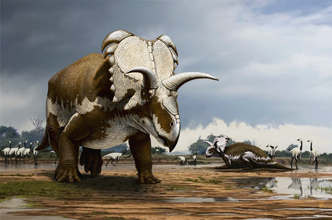
Medusaceratops Dinosaur meaning "Medusa horned face," is a fascinating dinosaur species that lived during the Late Cretaceous period, approximately 77-75 million years ago. This herbivorous dinosaur belonged to the ceratopsian group, which includes famous dinosaurs like Triceratops. With its distinctive skull ornamentation and unique features, Medusaceratops provides insights into the diversity and evolution of horned dinosaurs. Medusaceratops was a medium-sized dinosaur, measuring around 15 to 20 feet (4.5 to 6 meters) in length.
Its most striking characteristic was its elaborate skull adorned with multiple horns and frills. On top of its head, it had a pair of long brow horns pointing forward and slightly upward. Additionally, it possessed a prominent nose horn that projected forward from the snout. The frill, located at the back of the skull, was relatively short and adorned with small, triangular spikes. The skull ornamentation of Medusaceratops likely played a role in display and species recognition, as well as combat and defense against predators or rivals.
Medusaceratops Facts :
| Name: | Medusaceratops Dinosaurs |
| Size: | 4.5 to 6 meters |
| Main Facts: | Medusaceratops, meaning "Medusa horned face," is a fascinating dinosaur species that lived during the Late Cretaceous period, approximately 77-75 million years ago. |
The varying shapes and sizes of the horns and frill spikes may have differed between males and females, indicating possible sexual dimorphism within the species. Like other ceratopsians, Medusaceratops had a robust and heavily built body. Its forelimbs were shorter than its hind limbs, suggesting that it primarily moved on all fours.
Fossil remains of Medusaceratops have been found in North America, specifically in Montana, USA, and Alberta, Canada. These regions were characterized by diverse habitats, including floodplains and forested areas. Medusaceratops likely inhabited these environments, feeding on vegetation and sharing its ecosystem with other herbivorous and carnivorous dinosaurs of the time. The discovery of Medusaceratops contributes to our understanding of the evolution and diversity of horned dinosaurs. Its intricate cranial ornamentation and adaptations provide valuable insights into the display behaviors and ecological roles of ceratopsians during the Late Cretaceous. By studying and analyzing these unique features, paleontologists continue to uncover the fascinating story of Medusaceratops and its place in prehistoric ecosystems.